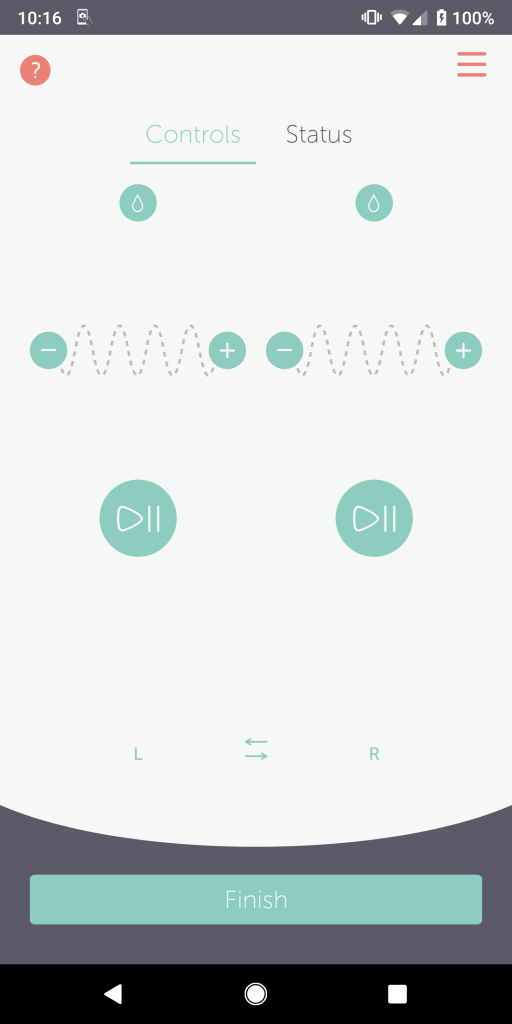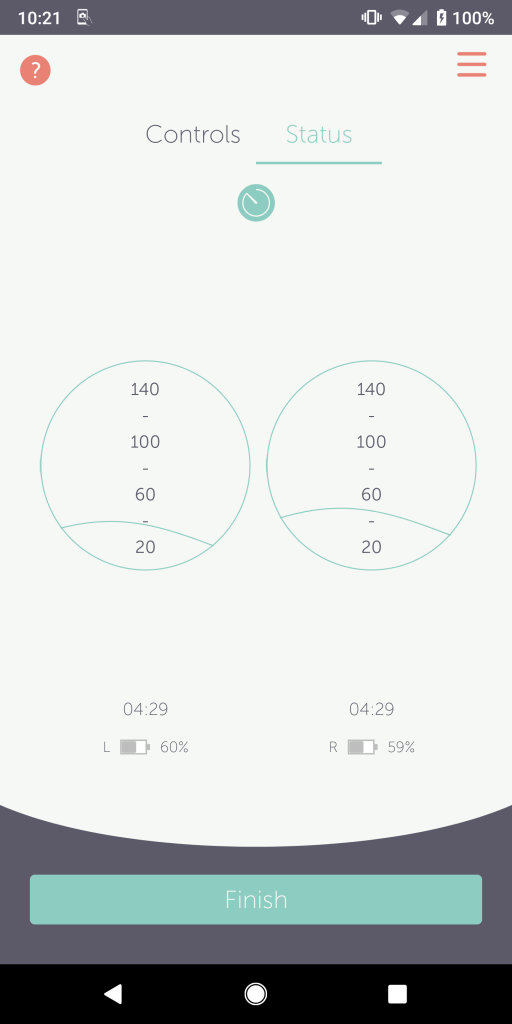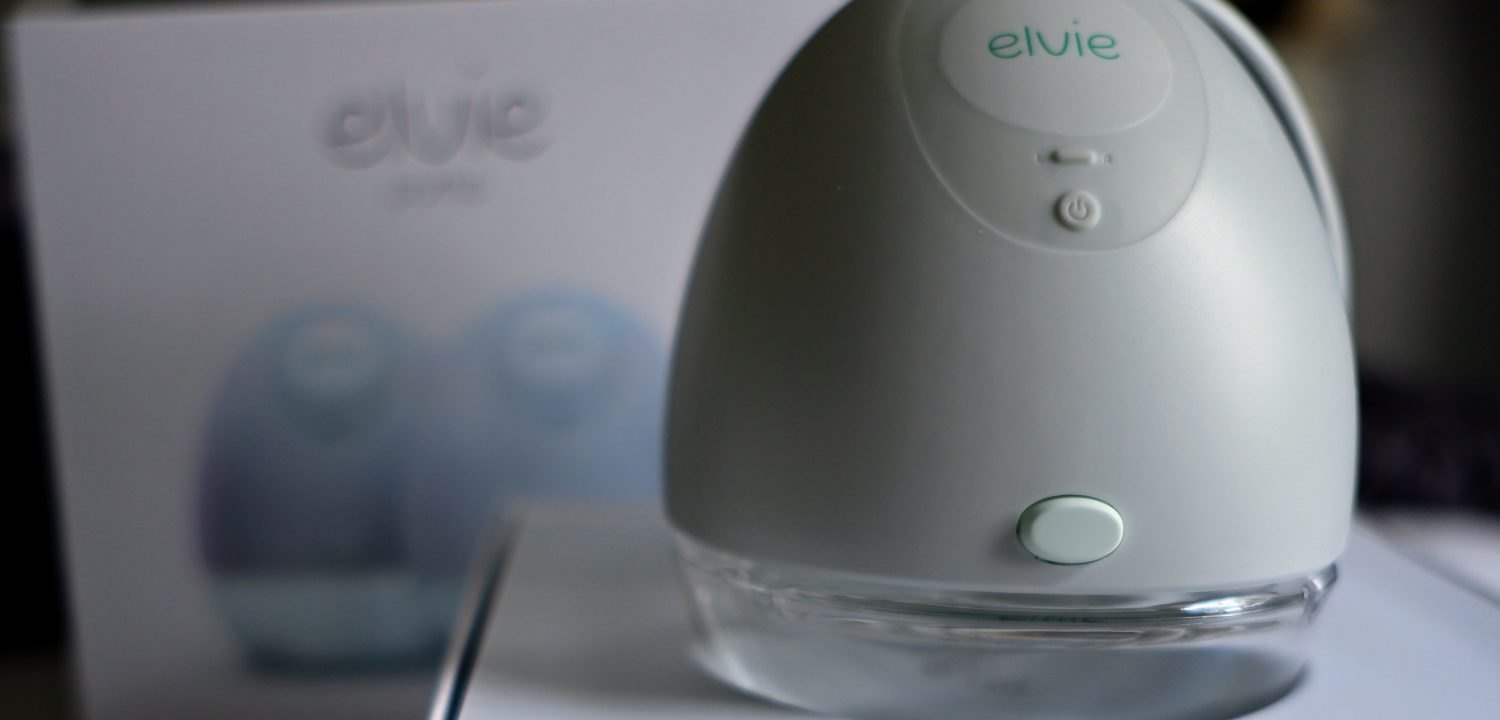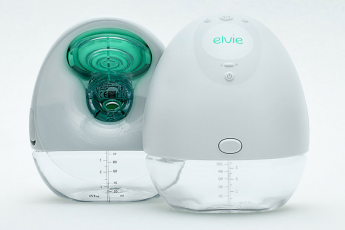Elvie first came on my radar through a Facebook Mom’s group and since then I’ve been so excited to be able to try it out. It finally came back in stock in the US mid-July of 2019 so I finally was able to get my hands on it. Here are my first impressions and (very thorough) initial review.
When I was pregnant and looking for pumps, the only true wireless/tubing-less/in-bra pump was the Willow pump, but I had read some not so great reviews about the suction of the Willow pump being weak, that there were various bugs in the software or hardware, and I didn’t like the idea of having to buy single use bags that I could only get from one vendor. Plus there were a lot of reports of the bags being filled up with air and then being “wasted,” requiring way more bags per pump session than you might expect. Also, they only had iPhone support for the longest time, so as an Android user, I passed on the Willow Pump even though the core premise – wireless, tubing-less, discreet in-bra pumping was a very appealing idea.
I became aware of Elvie a month or so ago and did a little research. They seem to be a UK-based company and their pump has been available in the UK for long enough for some reviews from across the pond to pop up. It seems like they only recently launched in the US. They seemed like a competitive alternative to Willow, with the same discreet in-bra pumping functionatity, except with reusable bottles. They also do have an iPhone and Android app. The only downside to the reusable bottles is that you still have to pump while staying mostly upright, to prevent leakage, whereas Willow advertises that you can pump in any position, including lying down, with no leakage. It’s a tradeoff I’m willing to make. They cost about the same amount of money.
In addition, many reviews talked about how incredibly quiet the Elvie was, allowing users to pump at work, pump in the operating room, pump in clinic, pump on phone calls, pump while talking to colleagues, all with no-one the wiser. That was really appealing to me, as my workspace does not have a dedicated pump area, and most conferences I go to don’t have dedicated pump areas either. Knowing that I’m going to be traveling a lot for conferences coming up, as well as being at work in the office more, I decided to bite the bullet.
Elvie is an expensive pump. I got mine through Aeroflowbreastpumps, and while the website does not work with my insurance, they did offer me a bit of an out-of-pocket discount. Others might be able to use their insurance to cover some of the cost, or HSA/FSA funds. Shipping took a week or so by FedEx SurePost (so slow), and that time was filled with anticipation, but yesterday I finally did get to unbox Elvie and try it out.
Unboxing and Setup

The box is pretty slick, looking very modern and in line with any iPhone/Android/fancy-piece-of-tech packaging nowadays. A bit classier than my BabyBuddha packaging.

Open it up and you’ll see the pumps standing up, resting on a little plastic cover with indentations to hold them there. It’s all fully assembled, with the 24mm shields installed. However, you will of course have to take it apart wash all the washable parts before first use.

Underneath the pump units is a whole set of extra parts, including two more bottles, bottle spouts, valves, membranes, and the pair of 28mm shields. There’s also 4 bottle lids, two little drawstring bags, one for each pump, and some bra strap extenders to help fit them into nursing bras if needed. There’s the manual also, and two USB charging cords (but no charging brick).
It prompts you to immediately start charging the pumps, so that is what I did. An LED indicator on the front face of the pump lights up orange while charging, and turns green when fully charged.
I then took apart all the parts to sterilize them before first use. The first thing I noticed was that there seemed to be a lot of parts.

For each side, there are 5 separate washable components: shield, membrane/diaphragm, valve, bottle, and bottle spout. It is okay to steam-sterilize (unlike Freemie cups, which expressly say in the manual not to steam sterilize) so I used my Medela steam bags to do the first clean. It’s a little bit extra awkward to manage all these parts, because the shield does not connect directly to the bottles. So, even with everything fully assembled afterwards (minus the pumps, which I try to keep separately to avoid getting them wet), there are two awkwardly shaped components to hold per side. I used to transport my parts up and down the stairs by just holding them but I’ve taken to just carrying the basin up and down the stairs to corral all the parts.
I do like the “build quality” of the plastic parts, however. They are made of a completely transparent/crystal clear plastic which is fairly hard and rigid, which seems unlike the Freemie cups, my Pumpin’ Pals flanges, or my Medela parts which are all of a semi-translucent, more flexible sort of plastic. These parts seem like they are built to last a long time (well, except for the bottle spout, which is more of that thinner plastic). The valves and membranes are silicone, and are pretty average/thin I would say. The pump units themselves felt sturdy enough, but not too weighty. You definitely wouldn’t want to drop them.
Use
I tried my first pump that night. Fully charged and all washed up, my Elvies were ready to go. I downloaded the Android app and followed the in-app instructions to pair my pumps to my phone. They made the setup and pairing very simple.
I chose a stretchy bra and tucked the Elvie’s into the my bra. It wasn’t hard to align my nipple to the flange, and Elvie thoughtfully added some markings onto the clear flanges to help the alignment. Then I used the app to start pumping.
The first thing I noticed was that because the two units are independent, the pumping rhythm is independent in the two breasts which is kind of an odd feeling if you’re used to a traditional pump. Even if you hit the “play” buttons to initiate pumping on both sides at the same time, eventually the rhythms will diverge. This just took a few minutes to get used to.
Suction
The pump starts in the letdown mode, which is just a fast sucking rhythm. There is no “long pull” the way that the Baby Buddha has. I found that I rather missed that long pull, but I was still able to letdown fine. It is supposed to automatically sense letdown and switch to expression mode, but I found that I just got impatient and switched it myself. Expression mode is a slower/stronger sucking rhythm. The level defaults to somewhere in the middle of the range. I tried it out up to the highest end of the range but it wasn’t super strong I would say. The feeling of the suction is…kind of cute? Like aww, what a cute little sucker. Maybe even slightly pinchy but not in a bad way. It was just…different compared to my BabyBuddha suction which has always felt strong and robust. One unexpected plus of having the two independent motors is that you can adjust the suction level independently in either breast. When one breast’s letdown finishes, you can go back to letdown mode for that side earlier.

I will say that because of the shape of the flange, it’s a bit easier to lose suction if the unit is not pressed up against the breasts tightly enough.

You can see here from the side profile that the back side of the pump unit is very flat. The only indentation is the part where the nipple/areola goes in which flares out to the rest of the flange very quickly. It is a smooth transition (like the Pumpin’ Pals flanges) without corners, so it’s quite comfortable. But, given how flat the flared part of the flange is, if the Elvie falls away a bit from your breast, for example if it leans forward instead of sticking closely against your breast, then it’s easy for the areola to pull out or to lose the suction seal around it. You really have to make sure the bra is adequately supportive of the pump in mushing it up against the breast even at the top of the pump. This part was a bit finicky, and it’s not as easy as the Freemie cups. The Freemie flanges are more traditionally funnel-shaped which makes more sense in fitting the natural shape of breasts, and so the breasts aren’t as likely to fall out of the flanges and lose suction.
Volume Estimates
In the app on a separate screen from the controls you can see the the app’s estimate of how much milk you are making. It estimates providing a little waving line animation that’s supposed to represent the milk level in your bottle, with the line moving higher and higher as the milk level supposedly is rising in the bottle. I rarely ever pump up to the bottle limit (about 145mL) so I’m not worried about the auto-stop feature that the pump supposedly has. That is a good thing, because the estimates are wildly inaccurate and for me, always on the low side. After you finish the pump session the app will give you an actual estimate in oz or mL of total production. The first time I pumped (at night) it estimated no output at all, but I measured 72mL total. The second time I pumped (in the morning), it estimated about 140mL total but I made about 105mL per side. The following night it estimated 20mL from the right and none from the left, but I had made 45mL on each side.

Milk Output
Speaking of milk output, I was worried that with the low suction that it I would not pump as much milk as I did with my BabyBuddha. The first night I made 72mL, as I mentioned, which was on the low side for me for that time but not unheard of. I usually make anywhere from 60-100mL at the before-bedtime pump, depending on what time I pump and how good baby’s last feed was.
The next morning was the real test. Lately I’ve been making 200mL or so with the BabyBuddha with the first morning pump, which is usually my largest volume pump of the day. Imagine my surprise when with the Elvie I made 210mL. So far it seems my fears of poor milk output are unfounded. We shall see with continued use.
Of note, though, with the BabyBuddha I could see when my letdown had ended and I was no longer ejecting any milk into my milk bags. With the Elvie, you can’t watch the process, just as with the Freemie cups. Sometimes I could hear the milk stream hitting the bottle but sometimes I couldn’t. As a result, I found myself pumping for an extra long time “just in case,” out of anxiety that I hadn’t made enough milk and therefore wanting to pump longer. I stopped myself at 20 minutes in the morning though; my usual pump time in the morning with the BabyBuddha is about 12-15 minutes.
Discretion/Multi-tasking
What was it like to have the pumps in my bra? Well, it was certainly liberating to be able to go about my day, preparing and eating breakfast while pumping, without bottles and flanges sticking out of my chest and no tubing or pump even to carry around. Before, I could still move around with my relatively small BabyBuddha but the Elvie’s take it to another level.
Yes, they do make your boobs look enormous but out in the real world with a loose shirt or scarf it would not be too noticeable. More noticeable would be the LED lights on the front of the pumps, which I could definitely see through my shirt. They definitely telegraph, “Hi, I am wearing two pieces of technology on my body!”

The pumps are definitely pretty quiet, more so than my BabyBuddha. They are not totally silent, which is more obvious when pumping alone in a quiet bedroom. As I was walking around preparing breakfast, the noise of the pump faded easily into the background. I definitely could be out and about or on a phone call and pump discreetly, I think.
I did not experience any leaks, as some previous reviews have reported. Of course, I was not ballet-dancing like the Instagram advertisement I’ve been seeing. I also did not do anything strenuous nor did I lean over (wasn’t brave enough to brush my teeth while pumping because I lean over a lot to do that). However, I never make much more than about 100mL per side on most pumps so I’m not worried about overflowing the bottles. I also don’t expect to do much leaning over while pumping – mostly I’d be doing things like typing, maybe driving, walking around a bit. I feel that this should not be a problem. In fact, I’m typing this post now as I pump and it’s definitely an awesome feeling not to have any flanges, bottles/bags, or tubing sticking out in front of me!
Takedown
After I was done pumping, it was pretty easy to take the units out of my bra with minimal mess. The bottles release with a click of a button, and the shields just pull out of the pump units, taking the membranes with them. You can’t just take the bottles off to do the milk transfer without also taking the shields off too, because the pumps don’t have anywhere stable to stand on if you only take the bottles off while leaving the shields on. So, to put the milk away you have to disassemble the whole thing and put all the parts down somewhere — so this takes some space and coordination which I have yet to fully optimize.
To transfer the milk you have the pull the valves off the pour spout to reveal the opening, through which you can pour out the milk. I noticed that because of the design of the bottle and the pour spout (has some irregular inner corners or edges), the milk doesn’t cleanly empty all the way out. There’s always a little bit more trapped inside the bottle, and you have to remove the bottle spout to get to the last milliliters. I find this to be rather annoying. The Freemie cups pour and empty more easily.
Also, because the bottle is much wider than the opening, you pretty much have to rinse out the bottle every time you use it. I think it would be hard to use something like a Medela quick wipe to sterilize the bottle in between uses, because I’m not sure I could reach all the corners of the bottle with the wipes, and on top of that I would have to get the last bit of milk residue out. Hmmm…only time will tell if this is a serious hindrance or not.
To Be Continued
I’ll be testing the Elvie more thoroughly in the coming days and weeks, including taking it on an international trip for a conference, so I’ll be pumping on planes and perhaps even in conference halls with this. I’ll be back with an updated longer-term review then.










Leave a Comment